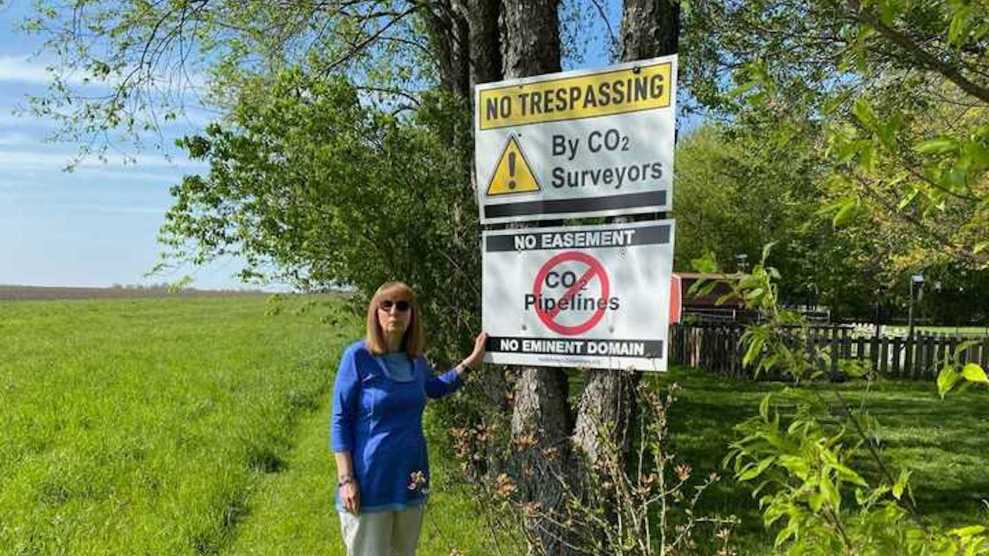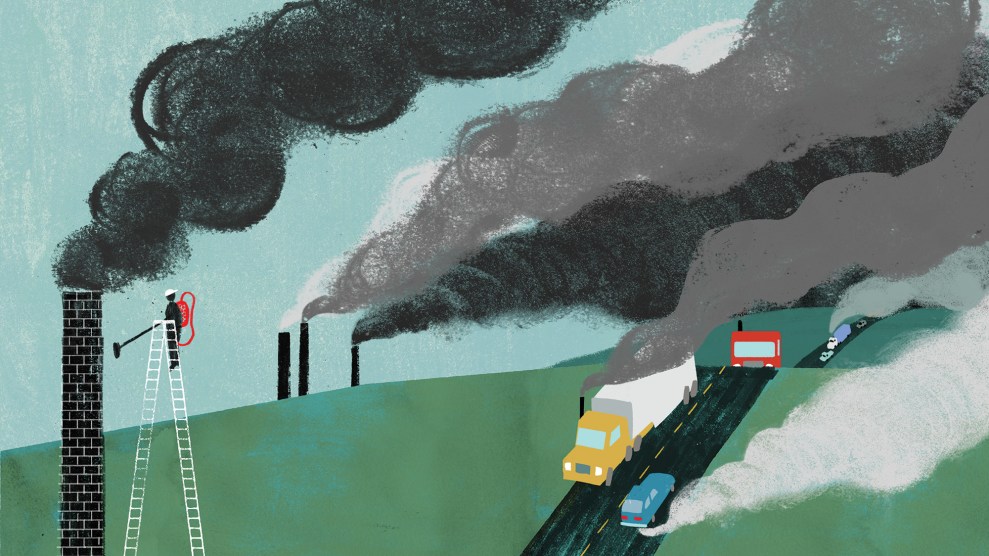
Kathleen Campbell at her rural home just south of Springfield, Illinois. Courtesy Kathleen Campbell
This story was originally published by Inside Climate News and is reproduced here as part of the Climate Desk collaboration.
After half a decade of failed attempts, Kathleen Campbell thought 2021 would finally be the year she retired. That is—until she received a letter in December from Navigator CO2 Ventures.
The company wanted to build part of its carbon dioxide pipeline through her property, about 1,000 feet from her rural Illinois home, just south of Springfield, which she had shared with her husband for more than 30 years. The massive project would ultimately span five Midwestern states, and Navigator was threatening to seize her property through eminent domain if she didn’t grant them an easement.
“This has absolutely ruined my retirement,” Campbell remembers thinking. Anxiety gave way to anger as she imagined a backhoe tearing up the beets, peppers and other vegetables growing in the quarter-acre garden that she and her husband had spent years cultivating. Later, she would learn a CO2 pipeline in rural Mississippi had ruptured just a year prior, sending at least 45 people to the hospital.
But Navigator’s executives couldn’t have known who they were dealing with. A distinguished research professor at Southern Illinois University School of Medicine, Campbell had spent her life combing through complex health studies and thwarting deep-pocketed pharmaceutical companies from bringing potentially dangerous drugs to market. Within months, she had helped birth a formidable opposition campaign to the pipeline.
About two weeks ago, Navigator finally capitulated and canceled its project. The company officially cited “unpredictable nature of the regulatory and government processes involved” as its reason for the decision. But truth be known, it was landowners like Campbell whose opposition wore them down and proved decisive.
“I think that I feel safe in my own home now,” Campbell said in a phone interview on the day of Navigator’s announcement. “Happy doesn’t come near it—delighted, euphoric?”
Now, her retirement notwithstanding, Campbell has agreed to help another group of Illinois landowners fight yet another CO2 pipeline being proposed between Iowa and Illinois. Her fight, it seems, has only just begun. And the lessons she learned fighting Navigator may be more valuable than ever.
Navigator’s pipeline would have spanned 1,300 miles across South Dakota, Nebraska, Minnesota, Iowa, and Illinois. It was one of two massive carbon dioxide pipelines that had been proposed in the Midwest in 2021 as the Biden administration began pumping billions of dollars in federal funding into nascent carbon capture and storage technologies as part of its ambitious agenda to combat climate change.
The other pipeline—Summit Carbon Solutions—had been proposed earlier that year, and would stretch more than 2,000 miles from North Dakota to parts of Nebraska and Iowa. A third pipeline owned by Wolf Carbon Solutions, which would run 280 miles between Iowa and Illinois, was also being discussed but hadn’t been officially proposed.
The pipelines would deliver millions of metric tons of carbon dioxide captured every year from Midwest ethanol plants to underground storage facilities, where—ideally—the emissions wouldn’t warm the atmosphere. Technologies that can pull carbon dioxide out of smoke stacks or directly from the air have gained traction in recent years as a potential climate solution, with proponents arguing that they can be used to slash the emissions of industries like steel and cement manufacturing, which are notoriously difficult to decarbonize.
Developers for Navigator, Summit and Wolf say their projects would reduce the carbon footprint of the ethanol industry, which makes fuel from corn to add to gasoline. “Carbon capture is more than a proven technology—it’s essential infrastructure for our future,” Navigator, whose project was backed by ethanol giant Poet LLC, wrote on its website. “It’s what prevents excess carbon from being released into the air, what sustains corn markets and what keeps the Midwest economy viable.”
There are more than 5,000 miles of carbon dioxide pipelines currently operating in the United States today, mostly for enhanced oil recovery—a process that involves injecting CO2 underground to dislodge elusive petroleum deposits. But as the climate crisis worsens, energy experts believe that as many as 100,000 miles of CO2 pipelines could crisscross the country in the coming decades.
Carbon capture projects, as well as the pipelines needed to transport the CO2, have already received more than $1.8 billion in federal funding. More than $12 billion total has been earmarked for such efforts in the Bipartisan Infrastructure Law and the Inflation Reduction Act.
Many progressive groups, however, scorn the idea of throwing billions of dollars at a controversial technology that’s still too expensive to scale to the levels needed to make a meaningful dent in carbon emissions. Those critics say that money would be better spent on building renewable energy, and they worry that carbon capture provides an excuse to prolong the use of fossil fuels on a longshot promise that one day burning oil and gas could be climate friendly.
In fact, most projects intended to prove carbon capture’s feasibility as a scalable climate tool have failed, according to a 2022 report from the Institute for Energy Economics and Financial Analysis, a progressive think tank.
The analysis found that 10 of the 13 flagship carbon capture projects built between 1986 and 2019 either failed entirely or underperformed against their designed capacities, most by large margins. As little as 10 percent of the world’s carbon capture projects, the report said, actually managed to store the CO2 underground while as many as 70 percent of today’s carbon capture projects are used to extract more oil and gas, increasing global greenhouse gas emissions.
“Even if the carbon dioxide can be injected underground, there is no guarantee that it will stay there and not leak into the atmosphere,” the report’s authors wrote. “It is no solution for a climate-constrained world.”
Still, in April this year, as opposition to carbon dioxide pipelines swelled in Iowa, Illinois and the Dakotas, Navigator CO2 Ventures defended carbon capture’s usefulness in the fight to slow climate change. “Is it the golden key? No,” Elizabeth Burns-Thompson, Navigator’s vice president, told a Kansas City NPR affiliate. “But when partnered alongside other developments, investments, tools, technologies, that is how we make true progress.”
Campbell didn’t waste any time after receiving that first letter from Navigator in December 2021.
The following month, she called Joyce Blumenshine, who at that time led the Illinois chapter of Sierra Club. The environmental advocacy group had initially supported CO2 pipelines for climate-related reasons. But that support was now wavering as word spread about a pipeline explosion in Mississippi the previous year that sent an entire rural town to the hospital, nearly killing some of its residents.
In February 2020, on a cool Saturday evening, a CO2 pipeline owned by Denbury Inc. ruptured in the hills above Satartia, releasing 31,405 barrels of highly compressed liquid CO2, which quickly converted back into gas and erupted into a clear night sky. Weeks of heavy rain triggered landslides that weakened the pipeline, a federal investigation would later find. Once released, the invisible CO2 plume then traveled over a mile downhill before settling over Satartia, where residents began feeling its effects within minutes.
Typically, carbon dioxide accounts for less than one-tenth of 1 percent of the air we breathe. But at high enough concentrations, it can suffocate people. CO2 is heavier than air and displaces it, like someone hopping into a full bathtub, causing water to spill out the side. At a concentration of just 1.5 percent, carbon dioxide can exacerbate respiratory issues in people with pre-existing health conditions such as asthma. At 4 percent or higher, the National Institute for Occupational Safety and Health considers CO2 to be “immediately dangerous to life and health.”
What unfolded over the next two and a half hours in Satartia was like a scene from an apocalyptic movie, recalled Jack Willingham, the county emergency response director who led the rescue operations that night. People struggled to breathe. One person had a seizure. Some residents had fallen unconscious in the middle of the road, while others stood around in a daze, unresponsive to commands. Cars stopped running, since combustion engines require oxygen. And at least one first responder needed to be rescued and taken to the hospital.
“People think carbon dioxide isn’t dangerous,” Willingham said. “But a pillow isn’t dangerous either until you put it over your face.”
Miraculously, nobody died—a testament to the quick actions of Willingham and his crew, who initially thought they were dealing with a methane gas leak or maybe chlorine gas. But 45 residents were hospitalized and 200 others who lived nearby were evacuated. Some in Satartia would report three years later that they are still dealing with health issues stemming from that night, including increased frequency and severity of asthma attacks, headaches, muscle tremors and difficulty concentrating.
To Campbell, the Satartia incident was an omen. Navigator’s CO2 pipeline would run not even half a mile from her house, much closer than Denbury’s pipeline was to Satartia. “Right now, Navigator’s route is absolutely not safe,” she said, “and somebody’s going to get killed.”
Blumenshine agreed, so the two decided to team up. By February 2022, Campbell and Blumenshine had assembled a sizable coalition of Illinois landowners who now shared similar concerns about Navigator’s project. They met over Zoom to discuss fundraising and to strategize public awareness efforts. They hired a lawyer to officially participate in Navigator’s permit approval process with state regulators. And by August, the two had convinced every township along Navigator’s proposed route in Illinois to sign onto a resolution opposing the project.
Coalitions sprang up in other Midwest states, filled with equally concerned landowners feeling indignant that their properties might get seized. Spurred by public complaints, some Iowa counties even passed new laws to restrict how close a CO2 pipeline is allowed to come near homes, churches and schools, prompting lawsuits from both Navigator and Summit.
Navigator and Summit did not answer questions sent by Inside Climate News, but both companies have said publicly that their projects would be safely built and maintained.
Navigator’s Burns-Thompson has also told local news outlets in Iowa that the company has been meeting with emergency responders to eventually develop localized response plans in the event of a pipeline leak, and that “those are costs that are borne by us as the company.”
By the spring of 2022, it became clear that Navigator and Summit were in for a tough fight.
That March, the Pipeline Safety Trust, a nonpartisan think tank that advocates for best safety practices in the energy industry, released a scathing report titled “Dangerous and Under-Regulated,” which concluded that current federal regulations were wholly inadequate to protect the public from the unique dangers of CO2 pipelines.
Those threats, the report said, include that CO2 plumes can travel much farther than previously thought while remaining lethal; that the pipelines themselves can become deadly shrapnel following an explosion; and that CO2 pipelines are also uniquely vulnerable to ruptures from within.
“When water is in CO2, it reacts and creates carbonic acid, which is extremely corrosive and just eats through steel—and it happens very quickly,” Bill Caram, the report’s author and the Pipeline Safety Trust’s executive director, said in an interview. Current “regulations really are not prepared to deal with any of that.”
The organization sent the report to the Pipeline and Hazardous Materials Safety Administration—the federal agency that oversees the construction standards for pipelines that carry hazardous materials, including carbon dioxide—pointing out numerous regulatory gaps it believed PHMSA should address.
The message was clearly received. Around that time, PHMSA had also concluded its own investigation into Satartia, finding many of the same issues noted in Caram’s report. And in May, the agency announced new federal research efforts on carbon dioxide safety issues and said it would draft a new rule to strengthen its oversight of CO2 pipelines. The agency expects to release a draft version of that rule in January 2024, with plans of finalizing it by year’s end.
“The safety of the American people is paramount and we’re taking action to strengthen CO2 pipeline safety standards to better protect communities, our first responders and our environment,” PHMSA Deputy Administrator Tristan Brown said in a press release announcing the new efforts.
Still, many landowners, including Campbell, worried that Navigator and Summit might finish their projects before the new federal regulations are in place. Once built, federal regulators can’t require developers to replace parts or update their pipelines until they apply for new permits. So safety advocates and concerned citizens want state and federal regulators to hold off on approving any permits for CO2 pipelines at least until the new PHMSA rule is finalized.
Meanwhile, public opposition has continued to mount.
By August of this year, the mass mobilization of landowners had become a serious barrier to the projects. That month, North Dakota regulators rejected Summit’s permit application, citing concerns over “the welfare of the citizens of North Dakota.” The next month, South Dakota’s state utility board rejected the permits for both Navigator and Summit, citing similar safety concerns. Then on October 10, Navigator voluntarily withdrew its permit application in Illinois, only to cancel the project entirely the following week.
Opponents celebrated the news. “Everyone said we have no chance against foreign-backed, multibillion-dollar hazardous pipelines, but when hundreds of landowners band together with a unified legal strategy, we can win,” Brian Jorde, an attorney representing many of the Midwest landowners who opposed the pipeline, said in a statement.
Campbell celebrated too. She had spent $30,000 of her own money fighting Navigator and was relieved that her hard work had paid off. But her retirement would have to wait.











